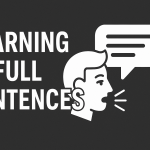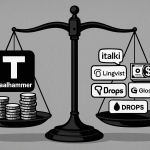Did you know that just 9 words cover 25% of spoken and written English? These words are: and, be, have, it, of, the, to, will, you. With another 50 words, you can cover almost 50% of the language. Add another 1000 words and you’ll cover around 80%!
Wow! So what’s the big deal about language learning if all you need is 1000 words?
In this article I am going to explain to you why this is not enough and what exactly do you need to do with these 1000 words. Then I’ll tell you how to become fluent in your foreign language faster than you might think. At the end, I’ll chat in Indonesian with an Indonesian lady – proving you can become fluent in 4 months!
How learning languages made my life an amazing adventure
My name is Mateusz and I’m co-founder of Taalhammer – language learning that works! During my lifetime, I’ve achieved fluency in four foreign languages.
Growing up in a small city in Poland, I suffered from a stutter. My life would probably have been boring if I hadn’t started studying languages.
I first started learning English when I was 14. German followed soon after. With growing confidence, my stuttering disappeared at age 17.
I became very fluent in both of these languages and went to Warsaw to study Applied Linguistics. Of 100 students there, only 6 were male. So I learned how to talk to girls and my adventures accelerated.
As part of a student programme, I worked a few months in the United States as a door-to-door books salesman. One day I knocked on the door of a German family and they were impressed with my English and German. They bought a lot of books from me and I caught the eye of their daughter, who was my age. I still remember her saying “Ich stehe auf Dich!” (which means ‘I got the hots for you’). She took me on a date to a local club in West Virginia and we kissed to the rhythm of 99 Luftballons (99 balloons)! How cool is that! After that we spent a wonderful few weeks together as a couple.
After returning from the US, I took the opportunity to study in Germany. I improved my German a lot, but I also took an Italian course at the university. I didn’t learn much at first, but enough to impress an Italian girl in one of my classes. We went for a coffee and had an interesting conversation about languages. At some point she told me ‘Siamo fatti l’uno all’altra’. I asked her what it meant. She answered ‘We are made for each other’. We kissed. And had a beautiful romance, we travelled a lot of Italy together and I became fluent in Italian.
After graduating, my language skills landed me a job in an AI start-up in Amsterdam. I decided to learn Dutch, which I used as a pick-up line to start conversations with ladies. Worked like a charm!
With even more confidence, I started travelling the world. I went to Thailand and learned some Thai – not much, but enough to impress an Indonesian lady who was living there. I met her at the bar in a beach club and I told her ‘Yindī thī̀ dị̂ rū̂cạk’, which means ‘Nice to meet you’. She smiled and told me that if I knew a magic password she would have a drink with me. Without hesitation I answered ‘Khwām s̄uk̄h thī̀ leụ̄xk dị̂’, which means ‘Happiness is a choice’, a phrase I learned earlier that day. We had several drinks together and we danced on the beach during the full moon. She invited me to Indonesia the next day and we spent a wonderful time together.
I decided to come to Bali and have currently been studying Indonesian for 4 months. But this time, it’s different – I’ve done the right things in the right way. And I can already speak Indonesian!
Like I said, my life would probably have been boring if I hadn’t started studying languages!
Let’s go back to the 1000 words!
Why learning 1000 words won’t lead to understanding
I used to think learning 1000 words is enough to speak a language. But here’s the sad truth. If you learn a list of the 1000 most frequent words, your understanding of a language will be close to 0%.
But didn’t I say before that 1000 words cover 80% of the language? Yes – but there’s a big difference between “covering” and “understanding”.
What 1000 words do we mean?
- First are the so-called closed sets of words: pronouns (e.g. “she”, “we”), prepositions (e.g. “on”, “to”), determiners (e.g. “the”, “these”) and numbers.
- Then you need to learn the most frequent words – preferably in colloquial rather than academic language.
- Finally, we only count the base forms of words (called lemmas), which can change by adding suffixes, prefixes etc. ‘Go’ and ‘going’ are just one word.
In Taalhammer we have applied advanced statistical methods to compute 1000 words according to these principles. We call it the core of the language.
And make no mistake, these 1000 words are absolutely essential to learn, but they are only filler material. The other 15–20% convey the real meaning!
So how many other words do you need to learn to communicate fluently?
Take control of your learning and become fluent
Well, it depends on your particular situation. Learn words that are applicable to your life, so you can talk about things you have something to say about. So if you want to talk about basketball, you should learn and repeat vocabulary and phrases related to that.
This is where most language courses and apps
make the biggest mistake.
They teach you situational language that isn’t applicable to you. What benefit is it to learn about art or cooking if I have zero interest in such things?
Duolingo goes a step further and teaches you sentences like “The moon is mad at the sun” or “Giraffes eat apples”. Not only are these sentences pure nonsense, but the vocabulary is applicable only if you’re interested in astronomy or safaris!
This is why you need to take active control
of your language learning!
Taalhammer’s Editor was designed specially to help you build your own vocabulary. Use it to:
- Search for vocabulary
- Find suggestions of sentences so you see words in context
- Automatically translate your own private sentences.
If you do all this, you’ll become fluent faster than you think!
Three important things about fluency
So what is fluency?
- Fluency means being able to sustain a conversation. It doesn’t mean using language flawlessly.
- Fluency doesn’t apply to all situations. Start with one topic, e.g. basketball or buying flowers. Master it well through repetition, then move on to other situations.
- Fluency isn’t about how many words you know, but how quickly you can combine those words in sentences that mean what you want to say.
This is where grammar comes in.
Learning grammatical rules first is against your nature
Here again is where some language courses make mistakes!
Grammar isn’t rules – it’s a statistical structure of a language. Rules (and exceptions) are only an attempt to describe this structure – they’re not the structure itself.
Our brains have been evolutionarily designed to discover this structure through pattern recognition – by taking lots of sentence examples and computing statistics. This is exactly what happened when you learnt your native language as a child. You heard lots of examples and developed reflexes that allowed you to intuitively create “grammatically correct” sentences.
Learning grammatical rules is against our nature. It’s the most tedious part of learning a language. It’s also one of the main reasons learners quit.
Don’t get me wrong, grammatical rules can be helpful, but they should be used only for reference. First you should learn a large number of sentences, to give your brain a chance to do what it was created for. Only after that can you look up grammar rules to explain what you’ve learned intuitively.
It’s like riding a bike. You don’t learn rules about balance and torque in order to cycle. You get on a bike and you try it out. Only after you’ve practised might you go to a book to solidify what you’ve experienced.
Develop language reflexes: learn sentences instead of words
So how do you learn the structure of a language?
Learn lots of sentences by heart. But not just any sentences:
- They must be short, optimally between 3 and 7 words.
- Each sentence must exemplify a particular grammatical or communicative pattern.
- At least 60% of each sentence should consist of at least 60% of words you know.
- Sentences should use the core of the language (the 1000 most frequent words).
- Sentences should be ordered in increasing complexity.
By learning like this, you’ll give your brain a chance to do what it does best.
In Taalhammer, we’ve carefully selected 3000 such sentences and combined them into what we call “Core Collections”, which we offer at three levels: absolute beginners, beginners and intermediate.
Learning from a Core Collection will teach you the fundamentals of the language: asking questions, negating, confirming, referring, disagreeing etc.
Think about it analogously to learning football. First you learn dribbling, passing, receiving and shooting. Only if you master those are you able to combine them into “playing football”.
Last but not least: you can know thousands of words and sentences, but if you don’t put them into practice and start speaking, you have little chance of becoming fluent. It’s only when you start speaking that words fall into place. Language evolved as a medium of communication, so start communicating and you will become fluent in your foreign language faster than you think!
Now I’ll prove it works! I see a pretty lady sitting alone, and I’m going to approach her and have a conversation in Indonesian. Wish me luck!
Go to www.taalhammer.com and start learning with Taalhammer – language learning that works!






